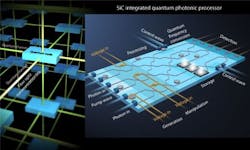Under a four-year, $2 million U.S. National Science Foundation (NSF) grant, Qiang Lin, assistant professor of electrical and computer engineering in the Hajim School of Engineering & Applied Sciences, will lead a photonics system integration research project to reduce the complexity and increase the capacity of quantum information processing for secure communication, metrology, sensing, and advanced computing.
The research is expected to result in a new class of device technologies with previously inaccessible attributes and merits that may eventually have profound commercial impact on the industrial sectors. SiC combines excellent linear optical, nonlinear optical, point defect, electrical, mechanical, and thermal characteristics into a single material with mature wafer processing and device fabrication capability, thus representing a promising material system for integrated quantum photonics.
“Our team will build chip-scale integrated silicon carbide quantum photonic processors for high-fidelity and energy-efficient quantum information processing, which interface seamlessly with fiber-optic links for secure communication and distribution of quantum information,” said Lin, principal investigator of the project and director of the University’s Laboratory for Quantum, Nonlinear and Mechanical Photonics.
Co-principal investigators are John Howell, professor of physics and optics, David Awschalom of the University of Chicago, Case Western Reserve University’s Philip Feng, and MIT’s Jurgen Michel. Members of the National Institute of Standards and Technology (NIST), Thomas Gerrits, Sae Woo Nam, and Richard Mirin, are also collaborating on this project.
Research such as this also feeds into the work of the AIM Photonics (American Institute for Manufacturing Photonics) consortium of the U.S. Department of Defense, of which the University of Rochester is a partner.
Source: University of Rochester
